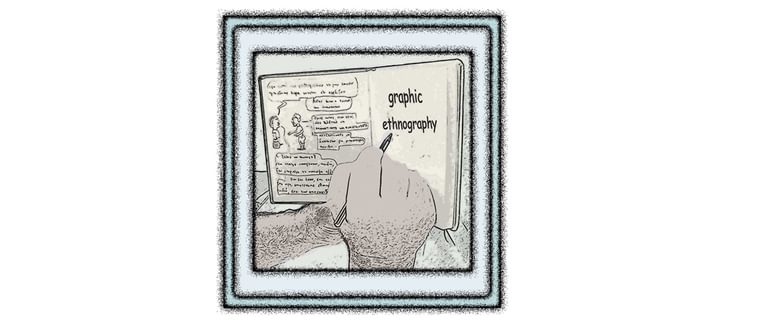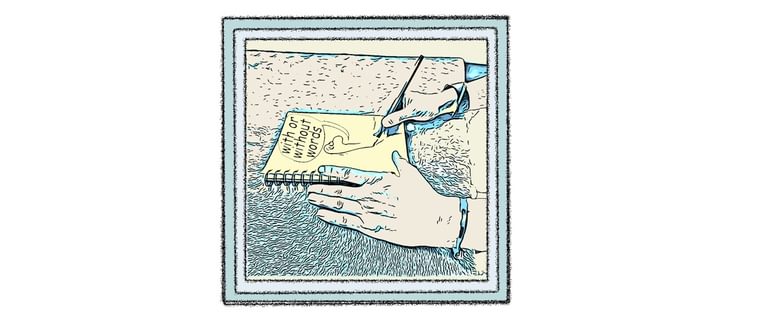Introduction: Graphic Ethnography on the Rise
From the Series: Graphic Ethnography on the Rise
From the Series: Graphic Ethnography on the Rise

Graphic ethnography has grown exponentially in the last decade. We have seen an unprecedented number of graphic-ethnographic experiments, taking place in diverse formats and publication venues: monographs, journal articles, blogs and PhD theses. These involve creative combinations of image and text—inspired by comics, political cartooning, graphic novels, and multimodal representational arrangements (which embed combinations of sound, video, or photography on a frame drawn digitally or by hand) (Theodossopoulos 2022; see also Haapio-Kirk 2022). Sometimes, graphic ethnography supports textual accounts, providing an additional dimension—aesthetic, sensual, artistic, or even analytic. Equally as often, graphic-ethnographic outputs take the form of stand-alone pieces—ranging in length from a single page to book size. They may rely on minimal text, or no text at all. But even when words are ubiquitous—in speech and thought balloons, or appear unconstrained among diagrams or drawings—the textual and visual elements coexist in a synergetic (and ideally, more equal) relationship.

The breath-taking variation of graphic-ethnographic forms has been met with overwhelming enthusiasm and optimism in anthropology. An increasing number of ethnographers are captivated by the scope of experimentation that graphic mediums engender, and some—as this feature demonstrates—introduce their own distinctive graphic-styles, borrowing from art and/or enabled by digital technologies (including new drawing software and digital mediums). At the same time, an older anthropological generation applauds the representational opportunities of this recent explosion of innovation, which grew alongside an earlier appreciation of anthropological drawing, sketching and design (see Taussig 2011; Ingold 2011, 2012; Marcus 2017, 2018). Although drawing and use of cartoons has a long history in anthropology, graphic ethnography acquired its own distinctive feel in the second decade of the twenty-first century, growing in parallel with other creative movements, such as imaginative ethnographic practices, live methods and multi-modality (Back and Puwar 2012; Culhane and Elliot 2017; Datttatreyan & Marrero-Guillamon 2019). Such innovative media represent an artful liberation of ethnography—an unsettling of fixed forms and a new vantage point (Taussig 2011, Caussey 2017). The emerging creativity challenges the hegemony of text in the production of knowledge and brings to the fore—once more—dilemmas about ethnographic representation.
At the current moment, we stare at this new wave of creativity with amazement and awe. We wonder if it is time to theorize those practices that stand under the umbrella term ‘graphic ethnography.’ Is such a label sufficient? Do we need a definition for the graphic-ethnographic genre, or a typology of the developing formats? Or, would definitions and labels constrain the scope and critical edge of graphic creativity?
The authors in this feature address some of these questions by putting images, sketches and words together—to think, interpret, feel and understand. They signpost some of the affordances of graphic ethnography—in providing illustration (of complex ideas), sensory dimensions (of social life), and a reflexive lens (to disrupt ethnographic authority). They also reflect upon collaboration with artists (Stacy Pigg, Sherine Hamdy & Coleman Nye) and key terms that indicate a relationship of graphic ethnography with other forms of art; e.g. comics (José Sherwood, Claudio Sopranzetti, Sara Fabbri, & Chiara Natalucci), illustration (Laura Haapio-Kirk), ethnographic drawing (Letizia Bonanno, Julie Spray). The latter, when used to define graphic ethnography may circumscribe—but also expand and refine—the scope of graphic-ethnographic-practice. We remain wary about narrow definitions that may constrain conceptually this new ‘graphic’ storm of creativity, yet appreciative about what this enables (Dimitrios Theodossopoulos, Laura Haapio-Kirk); for example, a renewed attention on the co-production of knowledge or aspects of social life that may pass unnoticed (Julie Spray, Stacy Pigg); or even, distinctive ways of thinking and meaning-making (Lochlann Jain, Elizabeth Povinelli).

While browsing the feature, you may be overwhelmed by the diverse styles and perspectives of the contributing authors. Some use the evocativeness of the graphic component to reflect theoretically and unsettle (Elizabeth Povinelli, Alisse Waterston, Lochlann Jain), while others surrender their analytical insights to the real-life sentiment of anthropological drawing (Stacey Pigg, Letizia Bonanno); choosing to focus on the melody of social life, rather than its lyrics (Charlie Rumsby). Many other contributing authors rely on graphics to enliven the narratives and experiences of fieldwork, dissolving the distance between us and them, decolonizing (Sherine Hamdy & Coleman Nye, Nayanika Mookherjee, Steven Van Wolputte, Lochlann Jain) or breaking up artificial dichotomies, such as that between language and image (Erika Hoffman-Dilloway). And some reveal—more explicitly than others—aspects of the making of graphic ethnography, including its collaborative production (Claudio Sopranzetti, Sara Fabbri & Chiara Natalucci, Stacy Pigg, Nayanika Mookherjee, Alisse Waterston), or its cultural embeddedness (José Sherwood). We have all emerged, we admit, more complete as ethnographers from thinking through images and drawing (Steven Van Wolputte).

There is no one specific order to read the articles in this feature. You may want to read from the beginning to the end, or vice versa, or from any other point in the order of presentation. Our styles contrast and overlap—which invites the reader to compare the breath-taking possibilities afforded by graphic ethnography. You may also want, we hope, to choose and emulate one or two ideas or representational tools. What makes graphic ethnography so exciting is its unpredictable lens, its proclivity to unsettle, its resistance to accept narrowly circumscribed representational formats. What follows in this feature, is not a linear presentation, but a creative splash of possibilities.
I would like to thank Neni Panourgiá for inspiring the idea behind this collection and the editors of Cultural Anthropology—Christopher Nelson, Heather Paxson, Brad Weiss—for carrying the project forward. I would also like to thank the contributing authors for sharing—generously—their ideas, graphic tools, and knowledge of graphic-ethnographic-practice.
Back, Les, and Nirmal Puwar, eds. 2012. Live Methods. Oxford: Wiley-Blackwell.
Causey, Andrew. 2017. Drawn to See: Drawing as an Ethnographic Method. Toronto: Toronto University Press.
Dattatreyan, Gabriel, and Isaac Marrero-Guillamón. 2019. "Introduction: Multimodal Anthropology and the Politics of Invention." American Anthropologist 121, no. 1: 220–28.
Elliot, Danielle, and Dara Culhane, eds. 2017. A Different Kind of Ethnography: Imaginative Practices and Creative Methodologies. Toronto: University of Toronto Press.
Haapio-Kirk, Laura, ed. 2022. Ethno-graphic Collaborations: Crossing Borders with Multimodal Illustration. Trajectoria Vol. 3. Special issue.
Ingold, Tim. 2011. “Introduction.” In Redrawing Anthropology: Materials, Movements, Lines, edited by Tim Ingold, 1–20. Farnham, UK: Ashgate.
Ingold, Tim. 2012. “Introduction: The Perception of the User-Producer.” In Design and Anthropology, edited by Wendy Gunn and Jared Donovan, 19–33. Farnham: Ashgate.
Marcus, George. 2017. “Foreword: Lissa and the Transduction of Ethnography.” In Lissa: A Story about Medical Promise, Friendship, and Revolution, edited by Sherine Hamdy and Coleman Nye. Toronto: University of Toronto Press.
Marcus, George. 2018. "Ethnography." Theorizing the Contemporary, Fieldsights, March 29.
Taussig, Michael. 2011. I Swear I Saw This: Drawings in Fieldwork Notebooks, Namely My Own. Chicago: University of Chicago Press.
Theodossopoulos, Dimitrios. 2022. "Carte Blanche: Graphic Ethnography and Its Multimodal Gifts." Trajectoria 3.